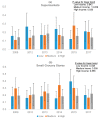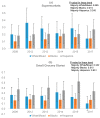Healthy Food Access in Low-Income High-Minority Communities: A Longitudinal Assessment-2009-2017
- PMID: 31277250
- PMCID: PMC6650883
- DOI: 10.3390/ijerph16132354
Healthy Food Access in Low-Income High-Minority Communities: A Longitudinal Assessment-2009-2017
Abstract
Disparities in healthy food access are well documented in cross-sectional studies in communities across the United States. However, longitudinal studies examining changes in food environments within various neighborhood contexts are scarce. In a sample of 142 census tracts in four low-income, high-minority cities in New Jersey, United States, we examined the availability of different types of food stores by census tract characteristics over time (2009-2017). Outlets were classified as supermarkets, small grocery stores, convenience stores, and pharmacies using multiple sources of data and a rigorous protocol. Census tracts were categorized by median household income and race/ethnicity of the population each year. Significant declines were observed in convenience store prevalence in lower- and medium-income and majority black tracts (p for trend: 0.004, 0.031, and 0.006 respectively), while a slight increase was observed in the prevalence of supermarkets in medium-income tracts (p for trend: 0.059). The decline in prevalence of convenience stores in lower-income and minority neighborhoods is likely attributable to declining incomes in these already poor communities. Compared to non-Hispanic neighborhoods, Hispanic communities had a higher prevalence of small groceries and convenience stores. This higher prevalence of smaller stores, coupled with shopping practices of Hispanic consumers, suggests that efforts to upgrade smaller stores in Hispanic communities may be more sustainable.
Keywords: convenience store; food access; food environment; grocery store; low-income communities; supermarket.
Conflict of interest statement
The authors declare no conflict of interest. The funders had no role in the design of the study; in the collection, analyses, or interpretation of data; in the writing of the manuscript, or in the decision to publish the results.
Figures




Similar articles
-
Longitudinal Associations Between Observed and Perceived Neighborhood Food Availability and Body Mass Index in a Multiethnic Urban Sample.Health Educ Behav. 2017 Feb;44(1):41-51. doi: 10.1177/1090198116644150. Epub 2016 Jul 9. Health Educ Behav. 2017. PMID: 27230271 Free PMC article.
-
Examining the relationship between the food environment and adult diabetes prevalence by county economic and racial composition: an ecological study.BMC Public Health. 2017 Aug 9;17(1):648. doi: 10.1186/s12889-017-4658-0. BMC Public Health. 2017. PMID: 28793887 Free PMC article.
-
The intersection of neighborhood racial segregation, poverty, and urbanicity and its impact on food store availability in the United States.Prev Med. 2014 Jan;58:33-9. doi: 10.1016/j.ypmed.2013.10.010. Epub 2013 Oct 23. Prev Med. 2014. PMID: 24161713 Free PMC article.
-
Neighborhood environments: disparities in access to healthy foods in the U.S.Am J Prev Med. 2009 Jan;36(1):74-81. doi: 10.1016/j.amepre.2008.09.025. Epub 2008 Nov 1. Am J Prev Med. 2009. PMID: 18977112 Review.
-
An Examination of Failed Grocery Store Interventions in Former Food Deserts.Health Educ Behav. 2019 Oct;46(5):749-754. doi: 10.1177/1090198119853009. Epub 2019 Jun 19. Health Educ Behav. 2019. PMID: 31216883 Review.
Cited by
-
Urban-Rural Disparities in Food Insecurity and Weight Status among Children in the United States.Nutrients. 2024 Jul 4;16(13):2132. doi: 10.3390/nu16132132. Nutrients. 2024. PMID: 38999879 Free PMC article.
-
Developing and evaluating a culturally-appropriate food kit for increased access to fruits and vegetables and DASH eating plan alignment in immigrant Hispanic/Latine individuals with hypertension: a pilot study.BMC Nutr. 2025 May 16;11(1):97. doi: 10.1186/s40795-025-01089-z. BMC Nutr. 2025. PMID: 40380253 Free PMC article.
-
Ultra-Processed Food Availability and Sociodemographic Associated Factors in a Brazilian Municipality.Front Nutr. 2022 Apr 20;9:858089. doi: 10.3389/fnut.2022.858089. eCollection 2022. Front Nutr. 2022. PMID: 35529462 Free PMC article.
-
Adult food choices in association with the local retail food environment and food access in resource-poor communities: a scoping review.BMC Public Health. 2023 Jun 6;23(1):1083. doi: 10.1186/s12889-023-15996-y. BMC Public Health. 2023. PMID: 37280606 Free PMC article.
-
Relationship Between Grocery Shopping Frequency and Home- and Individual-Level Diet Quality Among Low-Income Racial or Ethnic Minority Households With Preschool-Aged Children.J Acad Nutr Diet. 2020 Oct;120(10):1706-1714.e1. doi: 10.1016/j.jand.2020.06.017. Epub 2020 Aug 19. J Acad Nutr Diet. 2020. PMID: 32828736 Free PMC article.
References
-
- Agyeman J., McEntee J. Moving the field of food justice forward through the lens of urban political ecology: Moving the field of food justice forward. Geogr. Compass. 2014;8:211–220. doi: 10.1111/gec3.12122. - DOI
-
- Christine P.J., Auchincloss A.H., Bertoni A.G., Carnethon M.R., Sánchez B.N., Moore K., Adar S.D., Horwich T.B., Watson K.E., Diez Roux A.V. Longitudinal associations between neighborhood physical and social environments and incident type 2 diabetes mellitus: The Multi-Ethnic Study of Atherosclerosis (MESA) JAMA Intern. Med. 2015;175:1311. doi: 10.1001/jamainternmed.2015.2691. - DOI - PMC - PubMed
-
- Wing J.J., August E., Adar S.D., Dannenberg A.L., Hajat A., Sánchez B.N., Stein J.H., Tattersall M.C., Diez Roux A.V. Change in neighborhood characteristics and change in coronary artery calcium: A longitudinal investigation in the MESA (Multi-Ethnic Study of Atherosclerosis) cohort. Circulation. 2016;134:504–513. doi: 10.1161/CIRCULATIONAHA.115.020534. - DOI - PMC - PubMed
-
- Feng X., Astell-Burt T., Badland H., Mavoa S., Giles-Corti B. Modest ratios of fast food outlets to supermarkets and green grocers are associated with higher body mass index: Longitudinal analysis of a sample of 15,229 Australians aged 45 years and older in the Australian National Liveability Study. Health Place. 2018;49:101–110. doi: 10.1016/j.healthplace.2017.10.004. - DOI - PubMed
Publication types
MeSH terms
Grants and funding
LinkOut - more resources
Full Text Sources

